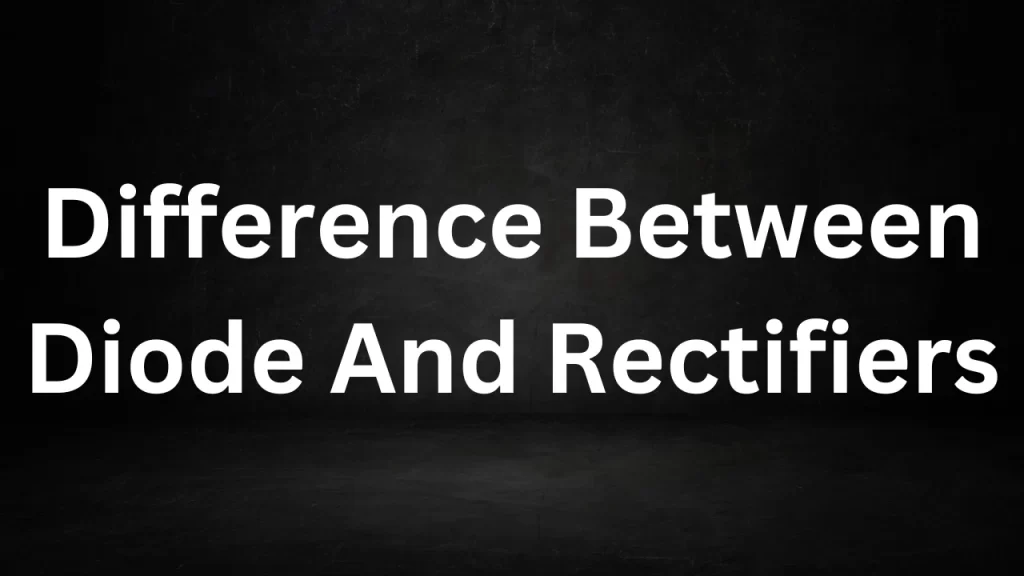Tag: Difference Between Diode And Rectifier
Difference Between Diode And Rectifier
Difference Between Diodes and Rectifiers: Diodes and rectifiers are electronic components commonly used in electrical circuits, but they serve different purposes. Here are the key differences between a diode and a rectifier:

Difference Between Diode And Rectifier
Function:
Diode: A diode is a two-terminal semiconductor device that primarily allows the flow of electric current in one direction while blocking it in the other direction.
It serves as a one-way valve for electrical current and is often used for tasks such as voltage regulation, signal demodulation, and signal protection.
Rectifier: A rectifier is a circuit or a device (usually consisting of multiple diodes) that converts alternating current (AC) into direct current (DC).
Rectifiers are specifically designed to rectify or convert the polarity of an AC signal, ensuring that the output current flows predominantly in one direction.
Number of Terminals:
Diode: A diode has two terminals: an anode (positive) and a cathode (negative). It allows current to flow from the anode to the cathode when forward-biased and blocks current when reverse-biased.
Rectifier: A rectifier typically consists of multiple diodes arranged in a specific configuration, such as a bridge rectifier or a full-wave rectifier. These rectifiers can have more than two terminals, depending on their design.
Typical Applications:
Diode: Diodes find applications in a wide range of electronic circuits, including voltage clamping, signal rectification, signal modulation, and protection against reverse voltage.
Rectifier: Rectifiers are specifically used to convert AC to DC. They are essential components in power supplies, battery chargers, and devices that require a constant source of DC voltage.
Direction of Current:
Diode: A diode allows current to flow in one direction (forward bias) while blocking it in the opposite direction (reverse bias).
Rectifier: A rectifier ensures that the output current flows predominantly in one direction, converting the AC input into a DC output.
Symbol:
Diode: The symbol for a diode typically consists of an arrow pointing towards a vertical line, representing the anode and cathode.
Rectifier: Rectifier symbols vary depending on the specific configuration but often include multiple diode symbols connected in a bridge-like pattern.
In summary, a diode is a fundamental two-terminal semiconductor device that allows current flow in one direction, while a rectifier is a circuit or device that utilizes diodes to convert alternating current (AC) into direct current (DC).
Rectifiers are specialized for converting the polarity of AC signals, making them a subset of diodes designed for a specific purpose.
Read More
- Basic And Standard Maths In Class 10 Sample Paper PDF
- CBSE Sample Papers for Class 11 English With Answers PDF
- CBSE Class 10 Basic Maths Question Paper 2020 With Solutions
- CBSE Social Science Class 10 Question Paper 2020 With Answers
- 10th Class All Subject Books Hindi Medium NCERT PDF Download
Frequently Asked Question (FAQs)
What is the primary function of a diode?
The primary function of a diode is to allow electric current to flow in one direction (forward bias) while blocking it in the opposite direction (reverse bias). It acts as an electronic check valve.
Can a diode be used to convert AC to DC like a rectifier?
No, a diode by itself cannot convert AC to DC. While it rectifies AC by allowing only one half of the AC cycle to pass, it does not convert the entire AC waveform into a smooth DC signal. A rectifier, which often includes multiple diodes, is needed for complete AC-to-DC conversion.
What are the terminals of a diode called?
A diode has two terminals: an anode (positive) and a cathode (negative).
What is the primary function of a rectifier?
The primary function of a rectifier is to convert alternating current (AC) into direct current (DC). It ensures that the output current flows predominantly in one direction.
Are rectifiers composed of multiple diodes?
Yes, rectifiers are often constructed using multiple diodes connected in specific configurations, such as bridge rectifiers or full-wave rectifiers. These diodes work together to achieve the AC-to-DC conversion.